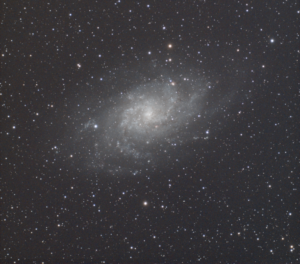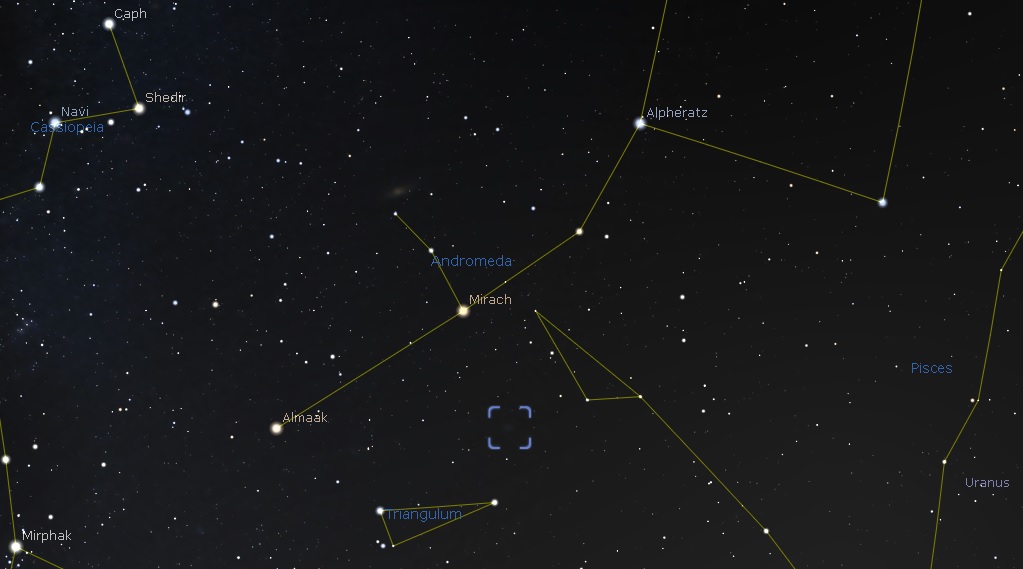
Telescope: Sky-Watcher 72ed Evostar
Mount: Sky-Watcher HEQ-5 Pro
Camera: ZWO ASI 533MC-Pro
Gain: 100
Filter: Optolong L’Pro 1.25 Inch
Totale exposure: 32 x 300 sec / 2 hours 40 Minutes
Guide Scope: ZWO MINI Guide Scope
Guide Camera: ZWO ASI 120MM
Exploring M33: The Triangulum Galaxy
The night sky is a treasure trove of wonders, each celestial body telling a unique story of the universe’s grand design. Among the countless stars and galaxies, one stands out for its intricate beauty and fascinating characteristics—the Triangulum Galaxy, also known as M33.
Introduction to M33
The Triangulum Galaxy is the third-largest member of our Local Group of galaxies, which includes the Milky Way, the Andromeda Galaxy (M31), and about 54 other smaller galaxies. Located approximately 3 million light-years away from Earth, M33 is named after the constellation Triangulum, where it is found. It is a spiral galaxy, similar in shape to the Milky Way but significantly smaller in size.
Discovering the Triangulum Galaxy
First documented by the Italian astronomer Giovanni Battista Hodierna in the mid-17th century, M33 was later independently discovered by Charles Messier in 1764, who cataloged it as the 33rd entry in his famous list of nebulae and star clusters. This discovery was crucial for the development of our understanding of spiral galaxies and their role in the cosmic landscape.
Structure and Composition
M33 spans about 60,000 light-years in diameter, making it a medium-sized spiral galaxy. Despite its size, it is relatively faint and challenging to observe with the naked eye. However, through a telescope, M33 reveals its stunning spiral arms, which are rich in star-forming regions.
One of the most remarkable features of the Triangulum Galaxy is its abundance of H II regions. These are vast clouds of ionized hydrogen where new stars are born. The largest and most notable of these regions is NGC 604, a colossal star-forming area that is one of the largest of its kind in the Local Group.
Star Formation and Evolution
The Triangulum Galaxy is a hotbed of star formation. Its spiral arms are peppered with young, blue stars that shine brightly against the darker backdrop of interstellar space. These stars, formed from the gas and dust within the galaxy, contribute to M33’s overall luminosity and make it an exciting subject for astronomers studying stellar evolution.
M33’s star formation rate is higher than that of the Milky Way, indicating that it is in a more active phase of its life cycle. The galaxy’s relatively low metallicity compared to its peers also provides clues about the conditions in which its stars form and evolve.
Unique Features and Phenomena
The Supermassive Black Hole That Isn’t There
One of the most intriguing aspects of the Triangulum Galaxy is its lack of a supermassive black hole at its center. While the Milky Way and Andromeda both harbor these massive objects at their cores, M33 does not appear to have one. This absence poses interesting questions about the formation and evolution of galaxies and the role these black holes play in galactic dynamics.
Interactions with Andromeda
M33 is also notable for its interactions with the Andromeda Galaxy. Gravitational forces between the two galaxies influence their shapes and star formation rates. These interactions are part of the complex gravitational dance that will eventually lead to the merger of Andromeda with the Milky Way, with M33 potentially playing a significant role in the resulting galactic evolution.
Observing M33
For amateur astronomers, M33 presents a rewarding challenge. It is best viewed under dark skies with minimal light pollution. Binoculars or a small telescope will reveal its faint glow, while more advanced equipment can showcase its spiral structure and star-forming regions. Observing M33 offers a glimpse into a dynamic galaxy teeming with activity and celestial wonders.
Conclusion
The Triangulum Galaxy, M33, is a captivating object in the night sky that provides valuable insights into the nature of spiral galaxies, star formation, and galactic interactions. Its relatively close proximity makes it an accessible target for observation, while its unique features continue to intrigue and inspire astronomers and stargazers alike. As we continue to explore the cosmos, M33 remains a testament to the complexity and beauty of our universe.
Processing and Editing Your M33 Image: A Detailed Guide
Capturing the intricate details of the Triangulum Galaxy (M33) is an exhilarating experience for any astrophotographer. The journey from raw images to a polished final photograph involves a series of meticulous steps. Here, we’ll walk through the process you used to create your stunning image of M33, from stacking your subframes in Siril to the final touches in Adobe Photoshop.
Capturing the Data
Your imaging session involved taking 32 individual exposures, each with a duration of 300 seconds. This method, known as long-exposure astrophotography, allows for the collection of a significant amount of light from the distant galaxy, helping to reveal faint details and structures within M33.
Why 300-Second Exposures?
Long exposures are crucial for capturing the faint light from distant celestial objects. Each 300-second subframe accumulates photons from M33, increasing the signal-to-noise ratio (SNR). This process is vital for reducing noise and enhancing the detail in the final image.
Stacking Subframes in Siril
Once you have your 32 subframes, the next step is to combine them using stacking software. Siril is a popular choice for this task due to its powerful algorithms and user-friendly interface.
Steps in Siril:
Pre-processing: This involves calibration with dark, flat, and bias frames. Dark frames account for sensor noise, flat frames correct for vignetting and dust spots, and bias frames adjust for sensor readout noise.
Alignment: Siril aligns the stars in each subframe to ensure they are perfectly overlaid. This step is crucial for maintaining sharpness and detail in the final stacked image.
Stacking: The aligned subframes are then combined. Siril averages the pixel values from each frame, enhancing the signal (the actual light from M33) while reducing random noise.
Post-processing: Basic adjustments such as background extraction and stretching are applied to bring out more detail and contrast in the stacked image.

Processing in Adobe Photoshop
With the stacked image from Siril, the next phase involves fine-tuning and enhancing the details using Adobe Photoshop. Here’s a breakdown of the steps involved:
1. Initial Adjustments
Levels and Curves: Adjust the levels to set the black and white points, enhancing the overall contrast. Curves can then be used to fine-tune the brightness and contrast, bringing out the faint details in the galaxy’s spiral arms.
2. Color Correction
Color Balance: Adjust the color balance to correct any color casts and ensure that the galaxy’s colors are natural. This step often involves enhancing the blues and reds to emphasize the star-forming regions and the older star populations.
Selective Color: Use selective color adjustments to fine-tune specific colors without affecting the entire image. This can help in enhancing specific features within M33, such as the H II regions.
3. Noise Reduction
Noise Reduction Filters: Apply noise reduction filters to smooth out any remaining background noise. Be cautious to preserve the details in the galaxy while reducing noise.
4. Enhancing Details
Unsharp Mask/High Pass Filter: Use these filters to sharpen the image. The unsharp mask can enhance fine details, while a high pass filter applied selectively can add crispness to the galaxy’s features.
5. Final Touches
Gradient Removal: Address any gradients or uneven illumination in the background using gradient removal tools or techniques.
Star Size Reduction: If necessary, reduce the size of the stars to make the galaxy stand out more prominently.
Final Color Tweaks: Perform final color adjustments to ensure the image looks natural and aesthetically pleasing.
Processing and editing your M33 image is a blend of art and science, requiring careful attention to detail at each step. By stacking your 32 subframes in Siril, you effectively enhanced the signal-to-noise ratio, laying a solid foundation for further enhancements in Adobe Photoshop. Through thoughtful adjustments in levels, color balance, and sharpness, you brought out the stunning features of the Triangulum Galaxy, turning your raw captures into a breathtaking final image.
I hope you enjoyed this blog and images about M33 – The Triangulum Galaxy
Happy stargazing! – Jimmy Keetman

